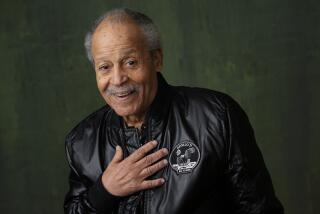Laurence Craigie, First U.S. Military Jet Pilot, Dies : Aviation: The retired Air Force lieutenant general was 92. In 1942, he flew an experimental craft that paved the way for the fighter jets used in the Korean War.
Laurence C. (Bill) Craigie, the retired Air Force lieutenant general who became the nationâs first military jet pilot when he flew the stubby Bell XP-59A Airacomet more than half a century ago, died Sunday. He was 92.
Craigie, who lived in Riverside, died at March Air Force Base Hospital of natural causes, said family friend Bradley Grose, of North Hollywood. Grose said Craigie had driven himself to the hospital two days ago because he was not feeling well.
The pioneering pilot modestly recalled his historic Oct. 2, 1942, flight two years ago during a ceremony at Edwards Air Force Base to commemorate its 50th anniversary.
âIt was a great thrill to be part of it. But it really wasnât as emotional a flight as you might think,â he said. âWe were just feeling out the aircraft.â
Craigie had made the historic 20-minute flight at Edwards (then Muroc Army Air Field) shortly after civilian Bell Aircraft test pilot Bob Stanley flew the craft. The United States was the fourth nation--following Germany in 1939, Italy in 1940 and Britain in 1941--to fly a jet plane. The Bell XP-59A never made it into World War II.
One of the warâs best-kept secrets, Craigieâs jet flight was not formally announced until 15 months after it took place. To conceal the jetâs development, Craigie and Stanley (who died in 1977) attached a wooden propeller to the aircraftâs nose when it was parked outside its hangar at Edwards and covered the air intakes for its twin jet engines with cloth.
The craft, and Craigieâs flight, paved the way for jet fighters in the Korean War.
The original XP-59A is on display at the National Air and Space Museum in Washington, D.C.
Despite two heart attacks, Craigie remained vigorous until near the end of his life. Two years ago, he celebrated his 90th birthday as co-pilot in a B-25 in a formation flyby with four vintage P-51 Mustang fighter planes over March Air Force Base.
âEvery 90 years weâre going to do this,â he said as he stepped out of the plane. âYouâre all invited in 2082. Iâll make all the arrangements with St. Peter.â
Educated at West Point and the then-new Air Force Academy in Colorado, Craigie was a pioneer aviator in both world wars.
Like so many fliers in the early years, he was forced in 1927 to join the âCaterpillar Club,â fliers who must parachute from a disabled aircraft.
Craigie was the first military man to fly in a radio-controlled aircraft and, during the 1930s and â40s, was among the engineers who greatly advanced flight, substituting sheet metal for wood and monoplanes for biplanes, and developing the turbojet engine.
During World War II, Craigie was named Allied air commander at Corsica, the island from which the invasion of southern France was launched in August, 1944. During the Korean War, he served 18 months as vice commander of the Far East air forces under Gen. Douglas MacArthur. After that war he served on the truce team.
Craigie was stationed for many years at Wright Patterson Air Force Base near Dayton, Ohio, where he befriended Orville Wright, the first man ever to fly under power. Craigie was with Wright when the inventor first saw a jet plane in flight.
Craigie continued to experiment with new types of aircraft until his retirement in 1955.
âOne thing you can say if youâre 90 years old,â he said two years ago, âis that all aviation--from the Wright brothers to the space shuttle--has happened in your lifetime. Isnât it wonderful that it could all happen in one lifetime?â
Craigie is survived by his wife of 68 years, Victoria Morrison Craigie; a son, Jack, of Los Angeles; a daughter, Gayle Craigie Chidlaw, of Boulder, Colo., and several grandchildren.
Services are scheduled for Saturday at March Air Force Base Chapel. At Craigieâs request, his body will be cremated and his ashes divided between West Point and the Air Force Academy.
The family has requested that any memorial donations be made to the Gen. Curtis LeMay Foundation.
More to Read
Inside the business of entertainment
The Wide Shot brings you news, analysis and insights on everything from streaming wars to production â and what it all means for the future.
You may occasionally receive promotional content from the Los Angeles Times.










